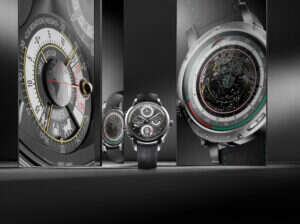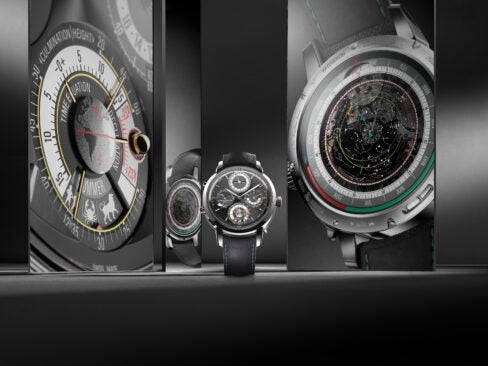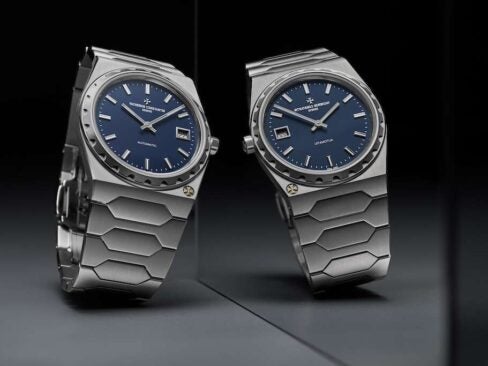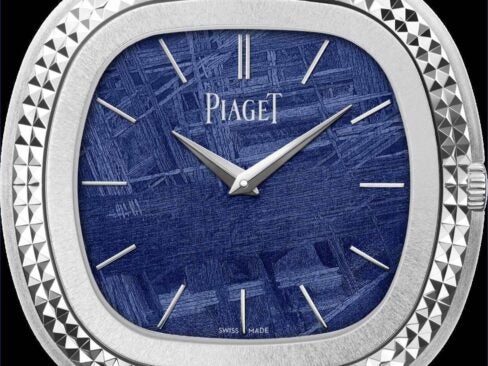
It’s a mouthful to pronounce but the idea is straightforward: The rattrapante, or split-seconds chronograph, is a type of chronograph that lets you time two intervals instead of only one.
A regular chronograph is nothing more than a stopwatch added onto a normal watch; examples include the famous Omega Speedmaster Professional, best known for having been flight qualified by NASA and used on all manned spaceflights. A split-seconds chronograph looks like a conventional chronograph, but instead of one hand showing elapsed seconds, there are actually two, one directly above the other. The two hands are superimposed and when the watch is started, they move together, looking exactly like a single hand.
Let’s say you’re timing a race between two runners. When the starting gun goes off, you push the start button and the chronograph starts running. In an ordinary chronograph you’d push the stop button when the first runner crosses the finish line. You’d know the winner’s time but not the time for the second runner to cross the finish line.
With a split-seconds chronograph you can measure both elapsed times. When the first runner crosses the line, you push the “split” button and one of the seconds hands stops, but the other continues to run. Push the “split” button again—traditionally, it’s mounted in the winding crown—and the first hand flies back to its position beneath the other. When the second runner crosses the finish line, push the stop button, and you can read off both the first and second place times.
It sounds simple but traditionally the split-seconds chronograph was considered difficult enough to make and adjust that it was accorded a rank as high in the hierarchy of complications as the minute repeater or perpetual calendar. Just getting the two hands aligned properly is a challenge. They’re typically hair thin, and they must be exactly superimposed for the complication to work as intended. The mechanism that lets the hands split and rejoin is also very delicate and, since it draws power from the mainspring of the watch, it has to be made precisely and adjusted carefully if disruption of the accuracy of the watch as a whole is to be avoided. In fact, the split-seconds chronograph is thought so challenging to make that it is one of three complications traditionally considered a part of any watch eligible for the title of grand complication.
While the term is used more loosely today, a grand complication watch traditionally combined the rattrapante chronograph with a minute repeater and perpetual calendar. (Interestingly, some traditionalists do not consider the tourbillon a proper complication at all, as it delivers no additional information; it is instead considered a regulating device.) Because of its complex construction, the rattrapante chronograph is a rarity and is often found traveling in the company of other complications in some of the most elaborate (and expensive) watches in the world.
Audemars Piguet has a long history of making watches that are grand complications in the traditional sense. During the height of the Great Depression, in the company’s worst financial year, it only made four watches, one of which was a grand complication. One of the brand’s newest grand complication watches is the Royal Oak Grande Complication, which, like the Royal Oak Equation of Time, places a group of classic complications in the contemporary Royal Oak case. The former incorporates a perpetual calendar and minute repeater as well.
Patek Philippe is probably the sole company most strongly associated with the rattrapante chronograph. The watchmaker creates the thinnest rattrapante chronograph movement in the world: Calibre CH R 27-525 PS. First introduced in 2005, it’s only 5.25mm thick, which is extremely thin for such a complex movement. Because of its svelte profile, some of the clearances in the movement are measured in tenths or hundredths of a millimeter. The movement is entirely assembled and finished by hand. It was first introduced in Patek’s ref. 5959, which now routinely sells in excess of $250,000 at auction. Perhaps the most breathtaking price associated with Calibre CH R 27-525 PS, however, is the retail value of the stainless steel, cushioncased chronograph ref. 5950A. When the watch was launched in 2010, its asking price was 440,000 Swiss francs, or about $461,943.









